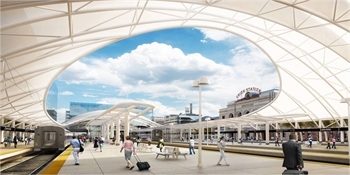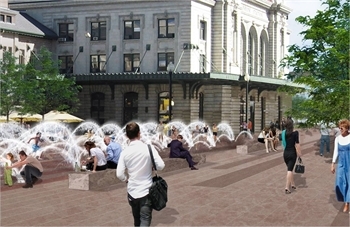
Photo by Abby Crisostomo
Frank Cannon, Tom Downs and Luann Hamilton speak at a March 14 Roundtable on stations as places.
When the iconic Chicago Union Station debuted in 1925, its design was a game changer in the world of long-distance rail travel. As noted previously, nearly 90 years after its debut, the station serves very different purposes now; its largest users are Metra commuters (more than 100,000 daily), and while it is the third busiest Amtrak station in the country, its users make up just 10,000 per day in comparison. Thus the need for baggage platforms has decreased significantly, as has mail with the rise of the Internet, and Chicagoans are left with a station designed for needs that we no longer have. On March 14, MPC hosted a panel of experts to discuss the best options for 21st century train stations that not only meet the technical requirements of rail but capture the energy and buying power of its passengers. In other words, what is the role of Placemaking in the planning and design of Union Stations across the country?

Washington D.C.'s Union Station offers multiple levels of passenger amenities
Photo courtesy of Peter Skosey
National transportation expert Tom Downs began with a tribute to the Roundtable’s host city, noting that given that the sweet spot for rail travel is between 60-350 miles, Chicago is the perfect hub. Downs pointed out that Chicago has always been able to capture the emerging transit mode of the day: first the Chicago River, then rail, then roads, and then airports. At this point, however, the other modes are constrained: highways and airports are out of room to expand, yet the capacity for rail is unlimited. He urged the audience to think of Chicago Union Station as an economic development tool, noting that in Washington D.C. (where Downs managed the overhaul of its Union Station into a multimodal hub of economic activity), the neighborhood with the highest investment is that directly north of the station. D.C.’s station is the primary economic driver in the district because it connects people not only to trains but also to public transit and innumerable amenities. It is a place in and of itself, of which trains are just one part. However, Downs pointed out that rail expansion requires one thing that Chicago does not yet have: a fully integrated, multimodal terminal.

Denver's new commuter rail line keeps the historic Union Station in view
Rendering courtesy of www.unionstationdenver.com
Continuum Partner’s Frank Cannon described how in Denver, the reconfiguration of their Union Station became about the creation of an entirely new neighborhood, in which transit is the spine but not the sole focus. The historic station was surrounded by 18 acres of abandoned rail yard, and once the land was purchased, Cannon’s development group was able to create a broad, largely at-grade footprint for light rail, commuter rail, expanded buses, and BRT. In return, this investment will boost land values around Union Station, creating new opportunities to finance the redevelopment by “capturing” that increased property value. Denver is using two value capture mechanisms, Tax Increment Financing (TIF) and special assessment districts to help fund the project.

One of Denver Union Station's many planned plazas
Rendering courtesy of www.unionstationdenver.com
Within this transit campus, 10 full acres of new public plazas were created. Cannon noted that the development around the infrastructure is what creates energy and excitement, and turns a transactional experience of catching a train into an interactional one in which a passenger might purposely arrive early to shop or get a bite to eat while sitting outside. In other words, the guiding philosophy behind Denver Union Station’s redesign into a district is transit first, but not transit only. In fact, $32 million of the $500 million budget was spent on public spaces.
Here in Chicago, where Union Station is the last of the city’s historic train stations, a Master Plan study is underway to assess solutions for technical constraints related to insufficient tracks and platforms, station congestion, and lack of connection to other modes of transit, as well as missed opportunities for the station to be a real destination.

Photo by Marisa Novara
Chicago Dept. of Transportation (CDOT)’s Luann Hamilton noted that their master plan study occurs at a pivotal moment for Union Station: since 2000, residential population in the Loop has increased 76% and doubled in the South Loop, corporations Sara Lee and DeVry recently announced new locations near the station, and conservative estimates of train demand show a 40% increase by 2040. The station and its surrounding blocks are poised to become an economic hub, which is why, Hamilton explained, CDOT’s study examines not only how to increase the technical capacity of the station, but also how to create a terminal that is vibrant, a civic asset, and a catalyst for growth.
There are multiple redevelopment opportunities both within the station itself and on surrounding parcels. We urge all of those involved in rethinking the potential of Chicago Union Station to consider transit as a vital part of a larger strategy to build an economic engine in the West Loop.
Continuum Partner’s Frank Cannon’s presentation
Chicago Dept. of Transportation’s Luann Hamilton’s presentation
Media coverage: